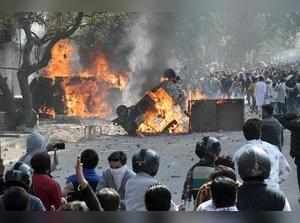
The Supreme Court's decision to defer the matter of the Shaheen Bagh protests to March 23 to allow ‘this fandom (sic) to cool down’, and its rebuke of the Delhi Police, could put some spark back into the protests, which has been flagging over the last few days.
The threat of another rupture lingers simply because what exactly triggered the clashes and mayhem is yet to be recognised. One narrative has it that the confrontation began when BJP leader Kapil Mishra -- who had earlier failed to get elected from Model Town constituency in the recently held assembly elections -- gave the call to supporters to evict CAA protestors over the weekend from sites they were occupying.
His call was incubated in the politics of hate and distrust. Anti-CAA protests may have been accompanied by incidents of street fights, stone-throwing and vandalism initially, but this was contained as a new face of ‘leadership’ emerged. From Shaheen Bagh in Delhi to Park Circus in Kolkata, Muslim women – including senior citizens -- took on a role they were least expected to take on, especially by themselves, and found support from other sections of society.
Yet, the anti-CAA protestors continued to be vilified -- sometimes by intricate hair-splitting -- especially through the Delhi election campaign, which witnessed several new lows from some members of BJP. The call for sections of the citizenry to take the law in their own hands always seemed round the corner, especially with BJP not sending out any clear message to its rank and file and supporters that provocation is not rewarded.
BJP's – and the government’s -- critics will rush to depict Mishra's battle-cry as part of a larger, nefarious plan. Yet, basic political – and common -- sense suggests that the timing of the riots and attacks could not have come at a worse time for GoI and Prime Minister Narendra Modi, with both pulling out all the stops to ensure visiting US President Donald Trump was given a grand welcome.
Yet, it is undeniable that there has been systemic failure in the manner the violence was handled. That the prime minister deputed National Security Advisor (NSA) Ajit Doval to visit Delhi's troubled streets and ensure that normalcy would indeed be the norm. Something Doval succeeded to do within hours, suggesting that the system works --
What led to bypassing the standard chain of command may never be known. But it does points to two governance-related concerns. One, by all reasoning, communal clashes in Delhi -- or anywhere, for that matter – shouldn’t have to be addressed by the NSA. He has enough, and greater, challenges on his plate.
Two, much of the police force across the country, continues to behave like the handmaiden of the ruling party, whether in the states or at the Centre. Added to this is a mindset among police personnel that their role is essentially the same it was during the British colonial period, when all dissent by ‘natives’ had to be curbed, brutally if need be. This anachronistic way of looking at protests effects parties across the political fence, with the consequence that every protest is imagined as a 'fight to finish' by all.
Delhi was on the boil since the middle of December last year. But on two occasions -- first in Jamia Millia Islamia, and later in Jawharlal Nehru University – Delhi Police, the most well-resourced police force of the country, either led the charge against protestors, or looked the other way when goons invaded campuses and beat up students and faculty. The charitable view is that because they were not pulled up by GoI, the police read the absence of any specific political directive as allowing them a free hand.
Indian politicians have long hidden behind the excuse that during elections, 'tempers rise', and much of what is said sotto voce should not be included as part of the political discourse. Opposition parties, more or less, remained silent fearing that they would alienate majority voters. Communal clashes are, obviously, not new in India. But this time, there was no ‘spontaneous trigger’ as has been the case in many past riots. But since mid-December, we witnessed far too many BJP leaders for comfort forsaking – or, rather, suspending – the PM’s talk of securing sabka vishwas (everyone’s trust).
One cannot but hope on the 150th birth anniversary of Mohandas ‘Mahatma’ Gandhi that political necessities will force the current political conversation India is having with itself to be tempered.
One cold statistic, however, stands out: 30% of injuries sustained in the last few days of Delhi violence have been from gun shots. The display of two men, in two separate incidents, openly brandishing a gun -- one purportedly from the CAA-supporting side, the other from the anti-CAA camp – disturbingly showcases a growing hair-trigger culture on more than just the proverbial level.
Read More News on
Download The Economic Times News App to get Daily Market Updates & Live Business News.
Subscribe to The Economic Times Prime and read the ET ePaper online.
Read More News on
Download The Economic Times News App to get Daily Market Updates & Live Business News.
Subscribe to The Economic Times Prime and read the ET ePaper online.









 Get Unlimited Access to The Economic Times
Get Unlimited Access to The Economic Times
